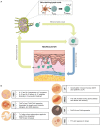The Translational Relevance of Human Circulating Memory Cutaneous Lymphocyte-Associated Antigen Positive T Cells in Inflammatory Skin Disorders
- PMID: 33833765
- PMCID: PMC8021783
- DOI: 10.3389/fimmu.2021.652613
The Translational Relevance of Human Circulating Memory Cutaneous Lymphocyte-Associated Antigen Positive T Cells in Inflammatory Skin Disorders
Abstract
Circulating memory T cells are heterogeneous in their tissue tropism. The skin-seeking T cell subset expresses the cutaneous lymphocyte-associated antigen (CLA) on their surface. CLA+ memory T cells not only migrate from blood to skin but also recirculate between blood and skin. Studying CLA+ memory T cells in cutaneous diseases has allowed a better understanding of immune-inflammatory mechanisms that take place. The analysis of the phenotypical features of these cells, their antigen specificity, cytokine production profile, and changes in relationship to clinical status and therapies among other characteristics have led to the concept that they constitute peripheral cellular biomarkers in T cell-mediated cutaneous conditions. CLA+ memory T cells are of relevance in the pathogenesis of several cutaneous diseases, such as psoriasis (PSO), atopic dermatitis, vitiligo, and drug-induced allergic reactions, to name a few. The interaction of circulating CLA+ T cells with skin-resident cells has been investigated in different ex vivo coculture models made out of clinical samples. Interestingly, microbes that are present in the skin or related with human skin diseases are preferentially recognized by CLA+ T cells. Thus, the interaction of Streptococcus pyogenes with CLA+ T cells in PSO is providing novel concepts that help to understand disease immunopathogenesis. The goal of this review is to present latest results in the field of CLA+ T cells in T cell-mediated inflammatory skin diseases and their translational relevance for human immunodermatology.
Keywords: CLA+ T cell; cutaneous inflammation; human; immunodermatology; skin-homing lymphocytes; translational.
Copyright © 2021 de Jesús-Gil, Sans-de SanNicolàs, García-Jiménez, Ferran, Celada, Chiriac, Pujol and Santamaria-Babí.
Conflict of interest statement
The authors declare that the research was conducted in the absence of any commercial or financial relationships that could be construed as a potential conflict of interest.
Figures

References
Publication types
MeSH terms
Substances
LinkOut - more resources
Full Text Sources
Other Literature Sources

